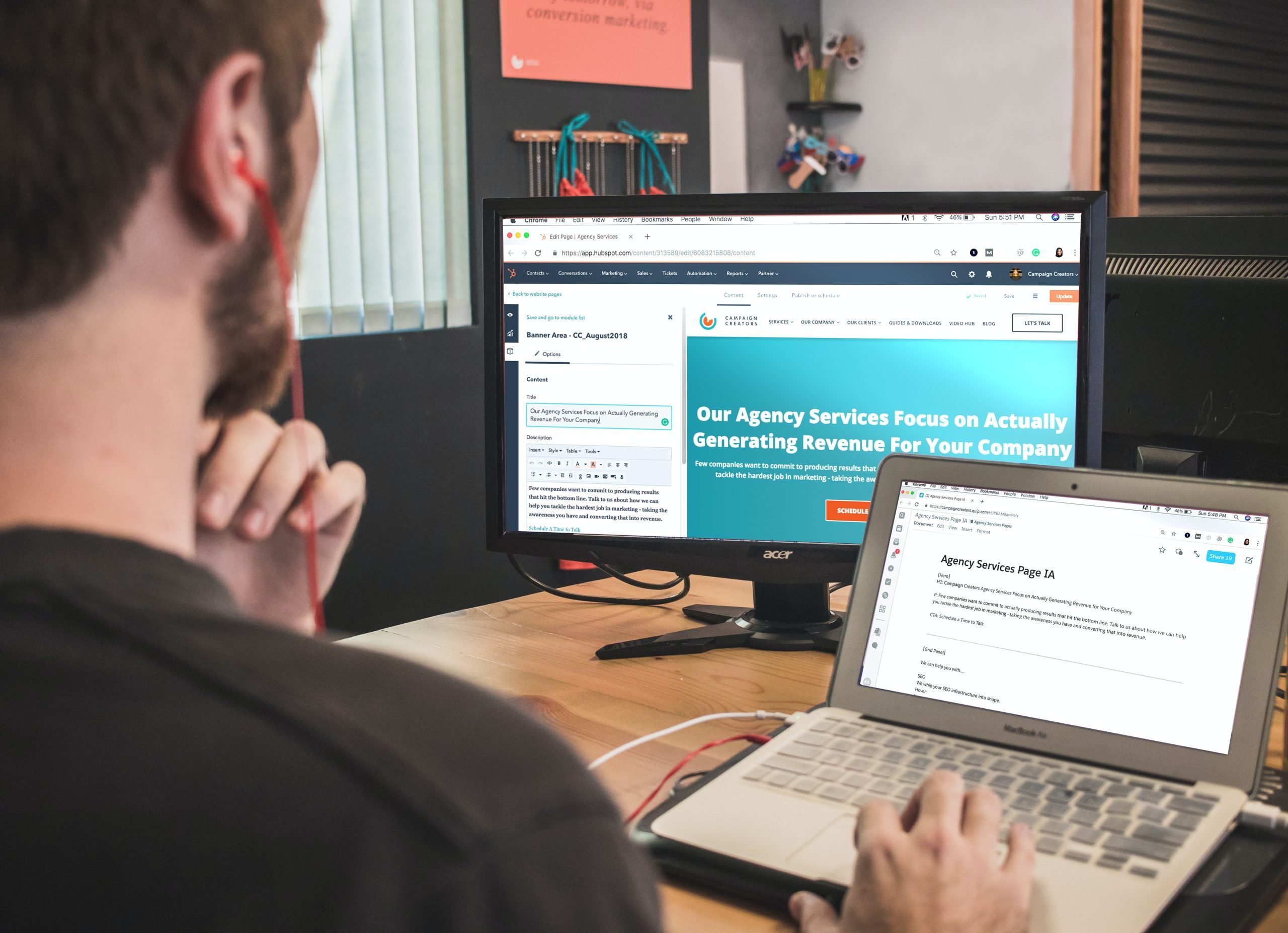What would you say if we told you that a subtle tweak of your homepage’s call to action buttons could be the difference between securing a conversion and losing a customer?
And, as hard as it is to hear, have you considered that you perhaps don’t know your reader as well as you thought you did?
Asking yourselves these kinds of questions can make all the difference between producing mediocre copy and compelling copy that has a real impact on how successful your business is online. Think about it; without being able to put a face to the page, or a voice to your words, your written copy is one of the few mediums your consumer can form impressions from. That’s why it’s so important to get it right.
Your website copy is the bread and butter of your overall content marketing strategy, and though just one cog in a wider wheel of digital marketing tactics, it is your brand’s distinctive voice. It feeds into everything from your organic social media posting and email marketing, to blog articles and even e-commerce product descriptions. It is the combination of words on a paid advert or social post that make all the difference for a consumer. Do you want to be letting your customer scroll past your advert and click on a competitor’s? We’d hope not!
Our digital marketing experts review and critique thousands of websites every year. Keep reading to find out our top 5 reasons why your copy isn’t converting, and what you can do to improve your current content strategy…
1. You Don’t Know Your Audience
The key to writing engaging copy, you ask? First and foremost, directly address your target personas. Find out exactly what your audience is receptive to, and what they love to engage with and centre your content around this. Start by profiling fictional customer personas, gathering information on their age, gender, location, hobbies, interests, what information or products they would be seeking from your business, and use all this data as the driving force behind your future content creation. Consider using an online persona builder template such as Hubspot’s ‘Make My Persona’ tool to get you started.
2. You Spend Too Much Time Talking About Your Business and Products
…and not enough time answering the questions that your readers want to know!
As well as asking yourself who your target reader is, you have to know the kinds of content that they are looking to consume. What needs or problems do they have that YOU can address?
Not only will this help you fulfil Google’s ‘relevancy’ criteria, but it will also boost engagement with the copy you are putting out, increase the average user session on your website, grow your website traffic and generate more conversions.
To find out what questions your audience is asking search engines, Answer The Public is an invaluable tool. If you’re struggling to get the creative juices flowing, Answer The Public is also fantastic for brainstorming content ideas which you can then work into your website’s copy. By simply typing in a word or short phrase related to your industry, specialism or subject topic, Answer The Public will generate a wheel of branches that contain specific questions.
Given that the main objective of a search engine is to provide people with answers to their search queries, addressing questions generated by your research will not only promote the discoverability of your website but ensure they rank high up in search engine results.
3. You Haven’t Taken Readability Into Account
By this, we mean you’re simply not speaking to your audience in a way that they can easily digest. Particularly for B2B, we understand you may want to demonstrate expertise and elevate yourselves as specialists in a particular field, but cramming your copy full of jargon and buzz words can do more harm than good. You can still sound smart, get to the point and draw in your reader without long words. We’re humans talking to humans at the end of the day, and people don’t want to work with robots!
As well as being essential to a user’s experience on your website, your content’s readability can also affect your website’s Search Engine Optimisation. After all, how is your copy meant to secure conversions if it isn’t discoverable on search engines in the first place?
When it comes to readability, ranking algorithms are calculated based on the number of syllables in a sentence, meaning longer complex sentences make your content more difficult to read. The trickier your content is to read, the less likely Google is to feature your website high up in search engine results. Therefore, keep your sentences concise and scannable, using simple language where possible. This will help Google better identify specific keywords in your content.
Improve your content’s readability by adhering to the following practices:
- Use headings and subheadings to break up paragraphs and structure your content. Feature keywords that you want your website to rank for in H1/H2/H3/H4 headings, as Google prioritises headings over main bodies of text
- Keep sentences concise, aiming for around 20-50 words
- Use fewer polysyllabic words where possible
- Avoid over-stuffing your page with keywords
- Resist over-formating (italics, bold) but make the most of headings, bullet points and anything that will break up large blocks of text
- Create focal points on the page to engage the user, such as an infographic or CTA button
- Write persuasively using the active voice as opposed to passive
Don’t forget, you can test the readability of your website’s copy with a Reading Age Calculator. This calculates the reading age of your site and provides useful text statistics, including the percentage of complex words used and average syllables per word. You want to be aiming for a score of 60 or above. Anything below this, and you’ll want to consider re-writing your copy based on the above recommendations.
4. Your Call To Actions Lack Leverage
Imagine, you’ve spent time nurturing a prospective lead through the customer journey with engaging, compelling copy, only to fall at the last hurdle by not asking them to take action at the end.
Always ask your reader to take action and always ask yourself, is it clear what the reader’s next steps are? To make your CTA’s as clear and direct as possible, front them with verbs which inspire action i.e. ‘Discover’, ‘Explore’, ‘Buy’, ‘Subscribe’, ‘Launch’.
Don’t be afraid to create a sense of urgency and encouragement using negative CTA’s. These work particularly well for e-commerce businesses. Let’s compare ‘Get 10% off your first order’ with ‘Don’t miss out on 10% off’ for instance. The latter, negative CTA is far more compelling when made to seem time-sensitive.
5. You’re Not Testing Your Content Strategy
Measure, measure, measure. It’s so important to be analysing your current strategy and learning what your audience is most receptive to. There are also so many free tools out there to do the hard lifting for you! Consider running A/B experiments on Google Optimise, testing the wording and appearance of your CTA buttons, headings and any other content that guides customers through your sales process. This way, you’ll learn which content variant has the higher conversion rate and should be featured permanently on your website.
Two useful reports to look into on your Google Analytics, is the Exit and Landing Page reports. These two reports tell us where our efforts should be concentrated to drive conversions. Taking a deep-dive into your Exit Pages can uncover where users are leaving your website, and where the content need to be better optimised to recover lost leads.
Are You Interested In Copywriting or Content Marketing Services For Your Business?
Whether you’re an e-commerce business looking to boost sales, a startup business eager to establish your brand voice, or a service website struggling with stagnant enquiries, we can help you implement and sustain an effective strategy that aligns with your business goals. Book a free 121 with one of our digital marketing experts today.





